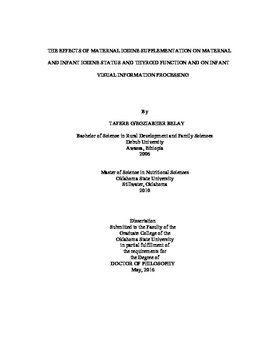| dc.contributor.advisor | Stoecker, Barbara J. | |
| dc.contributor.author | Belay, Tafere Gebreegziabher | |
| dc.date.accessioned | 2017-02-22T22:08:28Z | |
| dc.date.available | 2017-02-22T22:08:28Z | |
| dc.date.issued | 2016-05 | |
| dc.identifier.uri | https://hdl.handle.net/11244/48780 | |
| dc.description.abstract | Iodine deficiency is one of the major causes of preventable brain damage in childhood. However, iodine supplementation during early pregnancy and lactation could prevent the ill effects of iodine deficiency. In this study we have assessed the effect of iodine supplementation to lactating mothers on visual information processing (VIP) of their 6-month-old infants in a community-based, randomized, supplementation trial. Mother infant dyads (n = 106) were recruited within the first week after delivery to participate in this study. Study participants were randomly assigned either to receive 225 ug of iodine as potassium iodide capsule (capsule group) daily for 26 weeks or iodized salt (I-salt group) (450 g) weekly for 26 weeks. Lactating women (n = 53) who had 26 weeks old infants were recruited to serve as controls. Mother-infant dyads in the two supplemented groups were not significantly different in any of the biomarkers and anthropometry measurements at baseline. At the end of 26 weeks, maternal thryroxine (T4) decreased in the I-salt group (p < 0.001) but remained the same in the capsule group (p = 0.45), thyroid stimulating hormone (TSH) and triiodothyronine (T3) significantly decreased in both groups but there was no change in thyroglobulin (Tg). Compared to the two treatment groups, TSH was significantly lower in the control group. Maternal goiter rate significantly decreased following iodine supplementation. Infants median (IQR) T4 at 26 weeks was 10.8 (8.7, 13.6) ug/dL, 13.9 (10.6, 17.6) ug/dL and 19.6 (16.4, 25.9) ug/dL in the capsule, I-salt and control groups respectively. And the difference between the three groups was significant (p < 0.001). Compared to baseline, maternal and infant urinary iodine concentration (UIC) increased but breast milk iodine concentration (BMIC) decreased at the end of the 26 weeks. The percentage of infants who showed novelty preference to new stimuli above 0.55 was 26%, 51% and 47% in the capsule, Isalt and control groups respectively (p = 0.024), but other VIP tests did not show any effects of supplementation. In conclusion, iodine supplementation to iodine sufficient or mildly iodine deficient mothers did not show significant effects on infant VIP, T4, TSH or maternal T4, Tg, UIC and BMIC. | |
| dc.format | application/pdf | |
| dc.language | en_US | |
| dc.rights | Copyright is held by the author who has granted the Oklahoma State University Library the non-exclusive right to share this material in its institutional repository. Contact Digital Library Services at lib-dls@okstate.edu or 405-744-9161 for the permission policy on the use, reproduction or distribution of this material. | |
| dc.title | Effects of maternal iodine supplementation on maternal and infant iodine status and thyroid function and on infant visual information processing | |
| dc.contributor.committeeMember | Gates, Gail E. | |
| dc.contributor.committeeMember | Kennedy, Tay S. | |
| dc.contributor.committeeMember | Thomas, David G. | |
| osu.filename | Belay_okstate_0664D_14540.pdf | |
| osu.accesstype | Open Access | |
| dc.type.genre | Dissertation | |
| dc.type.material | Text | |
| thesis.degree.discipline | Nutritional Sciences | |
| thesis.degree.grantor | Oklahoma State University | |
